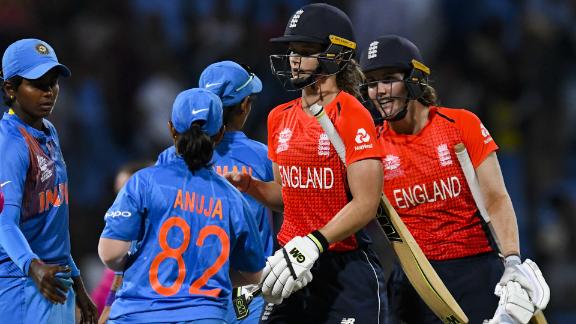England 116 for 2 (Jones 53*, Sciver 52*) beat India 112 (Mandhana 34, Rodrigues 26, Knight 3-9, Gordon 2-20, 2-22) by eight wickets
Eight wickets in hand, 17 balls remaining. Margins of victory can occasionally mislead, but this wasn't one of those occasions. England bossed India in every department at the Sir Vivian Richards Stadium, as they produced a masterclass of adapting to unusual conditions to deny India a maiden appearance at a World T20 final. England, who last won the tournament in its inaugural edition in 2009, will play their fourth final on Sunday, and meet Australia for the third time in the title match.
England's spinners laid the foundations for their success, with Sophie Ecclestone, Danielle Hazell, Katie Gordon and Heather Knight finishing with combined figures of 7 for 71 from 13.3 overs.
First, they gave England a measure of control, after Smriti Mandhana's calculated risk-taking had left India the happier side after the Powerplay. Then, after Jemimah Rodrigues and Harmanpreet Kaur had threatened to take the game away with a flurry of boundaries in the 12th and 13th overs, they ripped through the lower middle order - a problem area right through this tournament - sending India hurtling from 89 for 2 to 112 all out.
It was certainly a below-par total, but few would have predicted England chasing it down in such a friction-free manner. It helped that they knew their target, which ensured they were never forced into undue risk, and that India's passive fields diminished the wicket-taking threat of their spinners.
But it also helped that Amy Jones and Natalie Sciver, who steered England home with an unbroken third-wicket stand of 92, were so clear in their thinking and methodical in their execution of simple, common-sense plans. Those plans largely revolved around using the depth of the crease to pull, swat and muscle singles into the leg side as India's spinners, digging a trench on a shortish length and a wide line outside off stump, put long-on, deep midwicket and deep square leg on the boundary and for most part bowled without a single-saving fielder in front of square on that side of the wicket.
Deepti Sharma and Radha Yadav had applied a measure of pressure in the Powerplay overs, stringing together dot balls and forcing Tammy Beaumont and Danielle Wyatt into risks that cost them their wickets. Once the field restrictions disappeared, however, India were only too happy to push their field back, and concede a steady drip of singles. These were the fields of a team bowling first and looking to restrict their opponents to a manageable total rather than those of a team straining every sinew to pick up wickets.
Once Sciver survived an early drop - Poonam Yadav putting down a straightforward chance at square leg when she was on 2 - and settled at the crease, she began to nullify the boundary-riders. She showed remarkable bottom-hand strength to bisect long-on and deep midwicket with a front-foot swipe against one of Poonam Yadav's slow danglers wide of off stump, and then quick feet to step across to the off side and whip Anuja Patil wide of short fine leg.
Jones, who had given England the early impetus with nimble feet and inventive strokeplay - a back-foot swat back over Deepti's head in the third over, a whipped six over wide long-on off Radha in the fourth - slotted nicely into Sciver's slipstream, and the target rapidly shrunk. Sciver overtook Jones to fifty, before Jones brought hers up with the winning hit, a chip over mid-on off Patil in the 18th over. A hapless India had kept going back to their spinners despite Jones and Sciver neutralising them, and they didn't get a single ball out of Arundhati Reddy, their lone specialist seamer.
Apart from Reddy's non-utilisation, the other major talking point from India's perspective was their decision to leave out Mithali Raj, their most experienced player and the scorer of back-to-back fifties against Ireland and Pakistan. Her solidity with the bat may well have proved useful on this slow surface. Taniya Bhatia, who opened in Raj's stead, scored 11 off 19 balls, and Patil, who kept her place despite Raj recovering from the knee injury that had kept her out of India's last group game, fell for a first-ball duck and delivered 3.1 wicketless and expensive overs of offspin.
All this, though, can be said with the benefit of hindsight. What hurt India more than their selection decisions was the failure of their players to think on their feet and adapt to the conditions and match situation. Rodrigues apart, none of their batsmen used the depth of the crease and targeted the areas square of the wicket. Harmanpreet, Veda Krishnamurthy and Patil perished while looking to hit aerially and down the ground, lured into their doom by the flight and dip of Gordon and Knight.
There were three run-outs as well, and these dismissals echoed the panic that had cost India the World Cup final, against the same opposition, at Lord's last year. India came into this tournament saying they were better equipped to handle pressure situations, but on the evidence of this game, a little more learning remains to be done.



